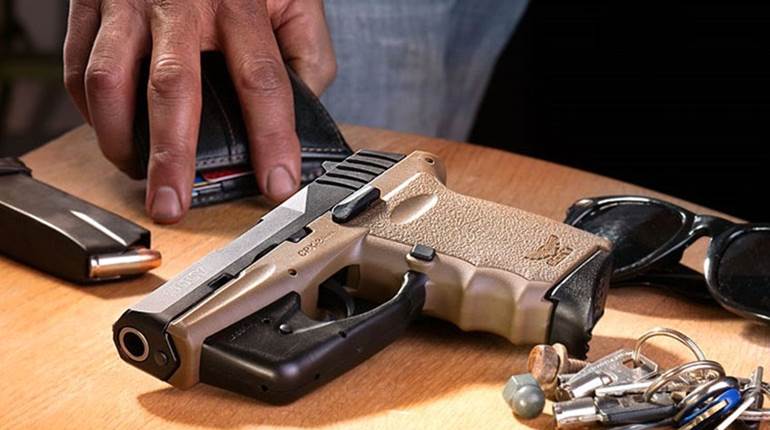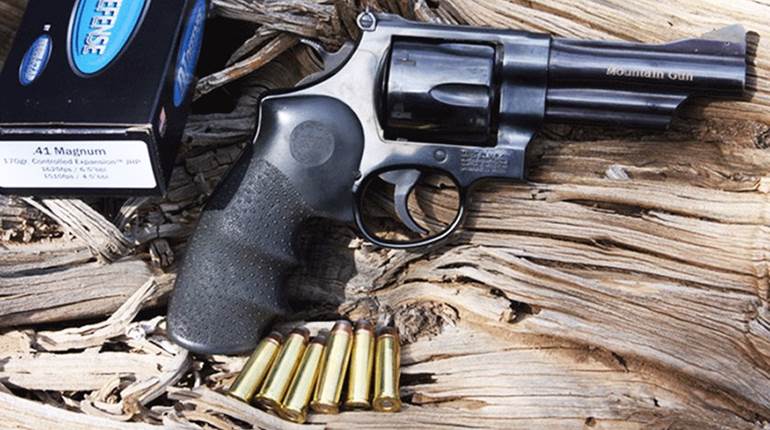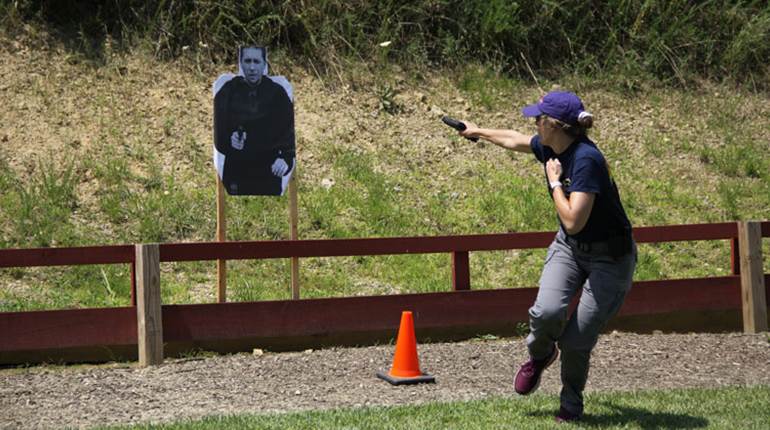
Springfield Armory’s reliable and affordable XD pistols proved to be immediately popular with the shooting public. Even a cursory glance will show why so many pistol enthusiasts were drawn to them when they first arrived on the scene back in 2002. The XDs have a lot of proven and desirable features including a grip angle and contour similar to the ever-popular M1911.
Technically described, the XDs are recoil-operated, center-fire pistols. Their slides ride on steel guide rails pinned to their polymer frames. Their familiar contours, combined with the improvements and simplified controls offered by their striker-fired system of operation, namely a short, light trigger pull of the same weight and length from the first to the last shot, make them very attractive to those looking for a handgun for competition or self-defense.
Additionally, XDs came with a wealth of safety features, including a cocking indicator on the rear face of the slide, a loaded-chamber indicator at the top rear of the ejection port and a trigger safety on the face of the trigger blade. A grip safety provided an added margin of safety.
In addition to its desirable combination of features, the XD had a remarkably adaptable design. Since the gun’s introduction, Springfield has developed a wide variety of stock and special-purpose XD-based pistols, offered in a complete range of defensive calibers, including: 9 mm Luger, .357 Sig, .40 S&W, .45 GAP and .45 ACP. XDs in these calibers are currently available in compact and subcompact variants for discreet carry as well as full-size models with extra-long or ported barrels for competition or home defense.
Having developed such a wide variety of models suited for just about any purpose, Springfield Armory redirected its efforts toward improving the XD’s ergonomics and mechanical accuracy. Accordingly, it chose action pistol competition as the ideal laboratory for maximizing the XD’s accuracy, endurance and reliability. The discipline of action pistol demands precision accuracy under stress and the expenditure of thousands of rounds in practice. The pressures of such demanding competition will expose a pistol’s weaknesses in short order.
The XD(M) pistols first reviewed in American Rifleman were the fruits of Springfield’s efforts to improve the gun. They are refined versions of the original Springfield XD pistol, so they share many of the same elements of construction and operation of their parent, but Springfield made a number of significant changes to improve their performance. At first, the XD(M) was available in just one chambering, .40 S&W, and one barrel length, 4.5 inches. But recently, Springfield has expanded the XD(M) line to include 9 mm Luger and .40 S&W variants with shorter barrels more suited to carry and, at long last, a .45 ACP gun with a full-length 4.5-inch barrel.
The more compact 9 mm Luger and .40 S&W models have been dubbed XD(M) 3.8, which reflects their 3.8-inch barrel lengths. Their barrels and slides are shorter than full-size XD(M)s, but the size of their frames remains unchanged. About the only visible difference between the XD(M) 3.8s and their 4.5-inch-barreled counterparts is the use of nested recoil springs. Although the XD(M) 3.8s are smaller than their full-size brethren, they cannot be called compact pistols. The shorter 3.8-inch barrels are comparable to most other full-size duty guns on the market. The original XD(M)s were if anything—because of their development in the arena of action-shooting competition—oversized. Their long 4.5-inch barrels were ideal for that discipline. The extra weight up front reduced muzzle flip and dampened recoil, the extra length increased sight radius and boosted velocity.
The shorter 3.8-inch barrels of the XD(M) 3.8s make them about the same size and weight as a full-size XD. So now shooters can have a gun with all of the ergonomic and mechanical improvements of the XD(M) in a gun that’s the same size and weight of the standard XD.
The XD(M) in .45 ACP is arguably the fulfillment of a promise. When the first XD(M)s appeared in .40 S&W, the first question on everyone’s lips was, “When’s the .45 coming out?” Well, it’s finally here, and there’s a lot to like about a gun that holds 14 rounds (13 plus one) of .45 ACP that still fits comfortably in your hand.
Springfield Armory incorporated a host of improvements into the XD(M) design, starting with increased magazine capacity. The original XD magazine holds 13 rounds of .40 S&W, whereas the XD(M) magazine is a double-column unit that holds 16 rounds. Witness holes punched into rear of the steel magazine body show the number of rounds remaining. Their greater capacity and stronger construction makes XD(M) magazines wider than standard XD magazines. This means that original XD magazines are incompatible with XD(M) pistols, and vice versa.
The magazine release button also received Springfield’s attention. Because a tall button can interfere with a shooter’s thumb or trigger finger, the company chose not to raise the XD(M)’s magazine release button. It is, however, prouder at the rear than at the front, which makes it easier to find by feel, and the area behind the magazine release is more deeply recessed so the button is easier to manipulate. There is a magazine release button on both sides of the frame, thus making it completely ambidextrous.
The gripping surface presented by the shape of the slide is important to proper gun handling and the shape of the XD(M)’s new slide makes for a better grip. It is wider at the bottom than at the top, so the fingers of the grasping hand meet increasing resistance from the contour of the slide.
The contours of the frame have also been refined. Like the original XD, the top of the backstrap is deeply dished for the web of the hand between the thumb and the forefinger. On the XD(M), this has been combined with a higher relief cut under the trigger guard in order to help the shooter achieve a high grip. Also, the bottom of the trigger guard is flat as well, so it is easier to index the support hand.
On both sides of the frame, the area behind the trigger well is gently recessed in the shape of a parabola, reducing the possibility of the firer’s index finger dragging along the side of the frame when the trigger is pulled. A deeper recess in the shape of an ellipse provides an index point for the knuckle of the firer’s thumb. These recesses can be found on both sides of the frame, so they are equally useful to both left- and right-handed shooters.
The XD(M) frame’s grip texture consists of a series of stepped panels on the frontstrap and backstrap. The depth of these pads is uniform, and the pads at the center are the widest, but the pads gradually decrease in width the farther they are from the center of the panel as they follow the curved contour of the grip frame. This texture is repeated on the flat face of the trigger guard.
XD(M) pistols come with interchangeable backstraps in three different sizes that allow the user to better match the size and contour of the grip frame for a better individual fit. And of course, better fit means better shooting.
Other changes to the frame include the XD(M)’s rail system. The dust cover has a three-position Picatinny rail that is 1.75-inches long; it has plenty of room to accommodate a variety of lights, laser sights or other shooting accessories.
The XD(M)’s sights come in a choice of three white dots, three red fiber-optic dots or three tritium dots. The face of the low-profile rear blade and front post are serrated to reduce glare and are dovetailed into the top of the slide.
Another change from the XD is that rotating the take-down latch drops the sear out of the way of the slide, so pulling the trigger to disassemble the gun for cleaning or maintenance is unnecessary. Safety features carried over from the standard XD pistol include a loaded-chamber indicator on the top of the slide at the rear of the ejection port and a cocking indicator that projects from the rear of the slide.
The Melonite finish on the Springfield Armory XD(M) is the product of a salt bath nitriding process that Springfield claims leaves a thicker, harder, more corrosion-resistant surface than traditional black oxide finishes. XD(M) pistols are currently available in a two-tone option: stainless slide, melonite matte black barrel and trigger, and black polymer frame; as well as an all-black matte Melonite and black polymer frame. XD(M)s come with a carrying case that holds the pistol, two spare magazines, a magazine loading tool and a carry strap.
When it comes to a trigger’s impact on accuracy and performance, its consistency and predictability is more important than its pull weight. The standard XD has always been commendably repeatable. As a striker-fired gun, the first trigger pull is the same as the last, but the XD(M) has reduced trigger reach, a quicker reset point and shorter take-up.
I had the opportunity to take an XD(M) 3.8 in .40 S&W and an XD(M) .45 ACP to the range. For accuracy testing, both guns were fired from a Ransom Rest using the adaptor for a standard XD pistol. Accuracy for both guns was commendable.
The recoil of the XD(M) 3.8 in .40 S&W was snappier than that of a comparable 4.5-inch-barreled gun in the same caliber. The shorter slide travel was the likely culprit, but that said, the gun was still very controllable and follow-up shots came quickly after I got used to the tempo of the shorter gun. In the end, the 3.8 is something of a compromise. It is certainly an accurate and smooth-shooting gun, but it is less forgiving than its 4.5-inch-barreled parent.
On the other hand, shooting the XD(M) .45 ACP was all pleasure. Most polymer double-column .45 frames are blocky so it can be a challenge to acquire and maintain a good repeatable grip. The blocky contours emphasize the fact that the frames are quite wide, so it’s difficult not to pull the muzzle off center when taking up a firing grip. But this is not the case with the XD(M) .45 ACP. It is a handful, but its transition between the side panels and frontstrap and backstrap is gently curved. As a result, I was able to maintain a proper grip, even after long shooting strings.
Both the XD(M) .45 ACP and the XD(M) 3.8s greatly expand the versatility and utility to the Springfield Armory’s XD(M) line of semi-automatic pistols. At long last, XD(M)s are available in .45 ACP, and with the 3.8 models the qualities of the XD(M) line are now available in a duty-size gun.
The XD is a good pistol, but the XD(M) offers a lot more. As choices in caliber and barrel length expand, a wider variety of shooters will be able to take advantage of the ergonomic and mechanical improvements that Springfield Armory has put into its XD(M) line.
Springfield XD(M) .45 ACP
Importer: Springfield Armory; (800) 680-6866; www.springfield-armory.com
Caliber: .45 ACP
Action type: Recoil-operated, striker-fired semi-automatic
Frame: Polymer
Barrel: 4.5"
Rifling: Six-groove, 1:16", RH twist
Magazine: Detachable box, 13-rd.
Sights: Low-profile, drift-adjustable rear blade with U-notch, post front
Trigger pull: 6 lbs., 2 ozs.
Overall length: 7¾"
Width: 1¼"
Height: 55⁄8"
Weight: 34 ozs.
Accessories: Three magazines, magazine loader, magazine pouch, holster, hard gun case
Suggested retail price: $707
Springfield XD(M) 3.8
Importer: Springfield Armory
Caliber: 9 mm Luger, .40 S&W (tested)
Action type: Recoil-operated, striker-fired semi-automatic
Frame: Polymer
Barrel: 3.8"
Rifling: Six-groove, 1:16", RH twist
Magazine: dDtachable box, 16-rd. (.40 S&W) 19-rd. (9 mm Luger)
Sights: Low-profile, drift-adjustable rear blade with U-notch, post front
Trigger pull: 6 lbs., 10 ozs.
Overall length: 7"
Width: 13⁄16"
Height: 55⁄8"
Weight: 30 ozs.
Accessories: Three magazines, magazine loader, magazine pouch, holster, hard gun case
Suggested retail price: $697 (black); $763 (bi-tone)





































